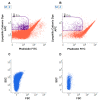Extracellular Vesicles as Signaling Mediators and Disease Biomarkers across Biological Barriers
- PMID: 32260425
- PMCID: PMC7178048
- DOI: 10.3390/ijms21072514
Extracellular Vesicles as Signaling Mediators and Disease Biomarkers across Biological Barriers
Abstract
Extracellular vesicles act as shuttle vectors or signal transducers that can deliver specific biological information and have progressively emerged as key regulators of organized communities of cells within multicellular organisms in health and disease. Here, we survey the evolutionary origin, general characteristics, and biological significance of extracellular vesicles as mediators of intercellular signaling, discuss the various subtypes of extracellular vesicles thus far described and the principal methodological approaches to their study, and review the role of extracellular vesicles in tumorigenesis, immunity, non-synaptic neural communication, vascular-neural communication through the blood-brain barrier, renal pathophysiology, and embryo-fetal/maternal communication through the placenta.
Keywords: biological barriers; biomarkers; extracellular vesicles; liquid biopsy.
Conflict of interest statement
The authors declare no conflict of interest.
Figures



References
-
- Butterfield N.J. Modes of pre-Ediacaran multicellularity. Precambrian Res. 2009;173:201–211. doi: 10.1016/j.precamres.2009.01.008. - DOI
Publication types
MeSH terms
Substances
LinkOut - more resources
Full Text Sources

